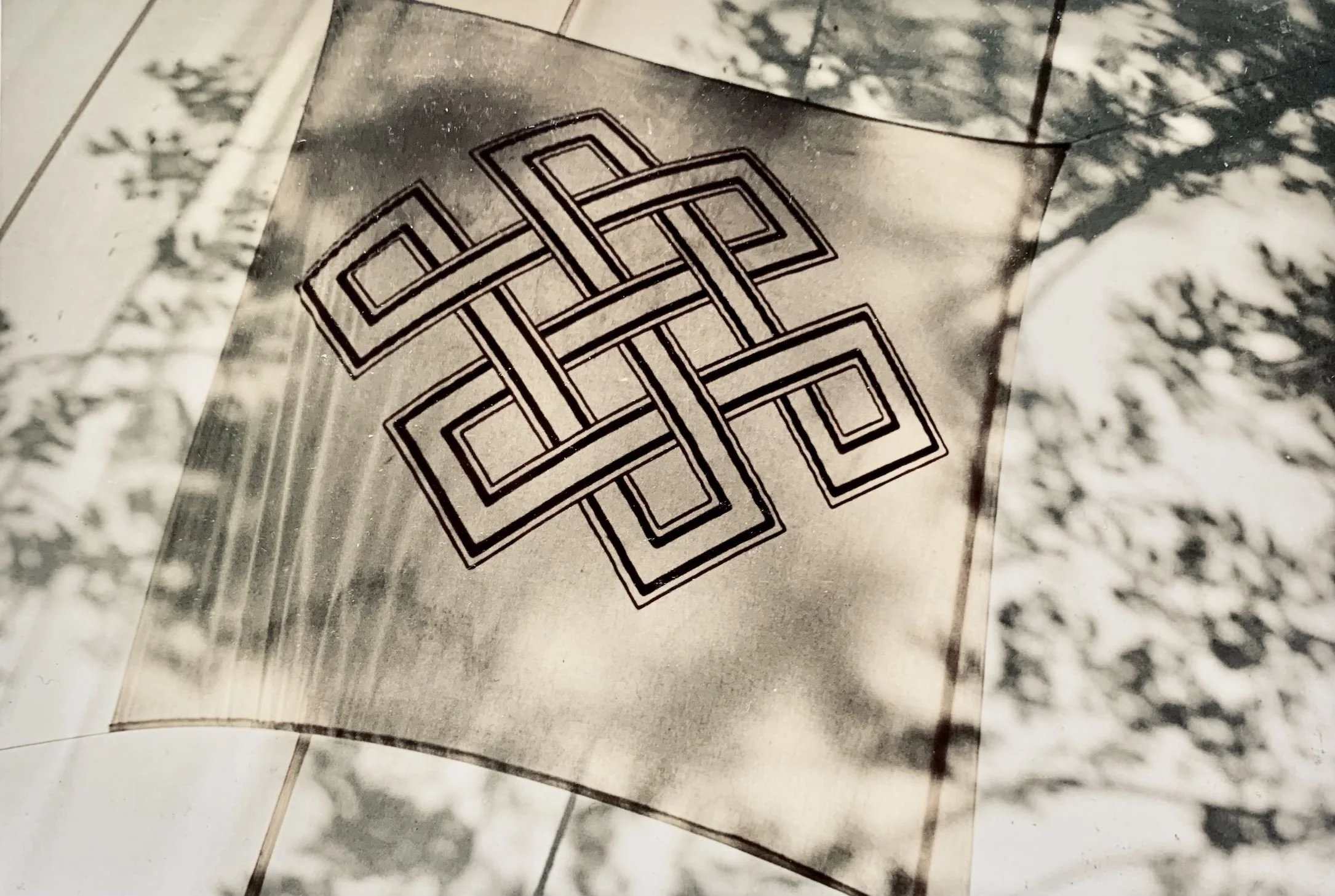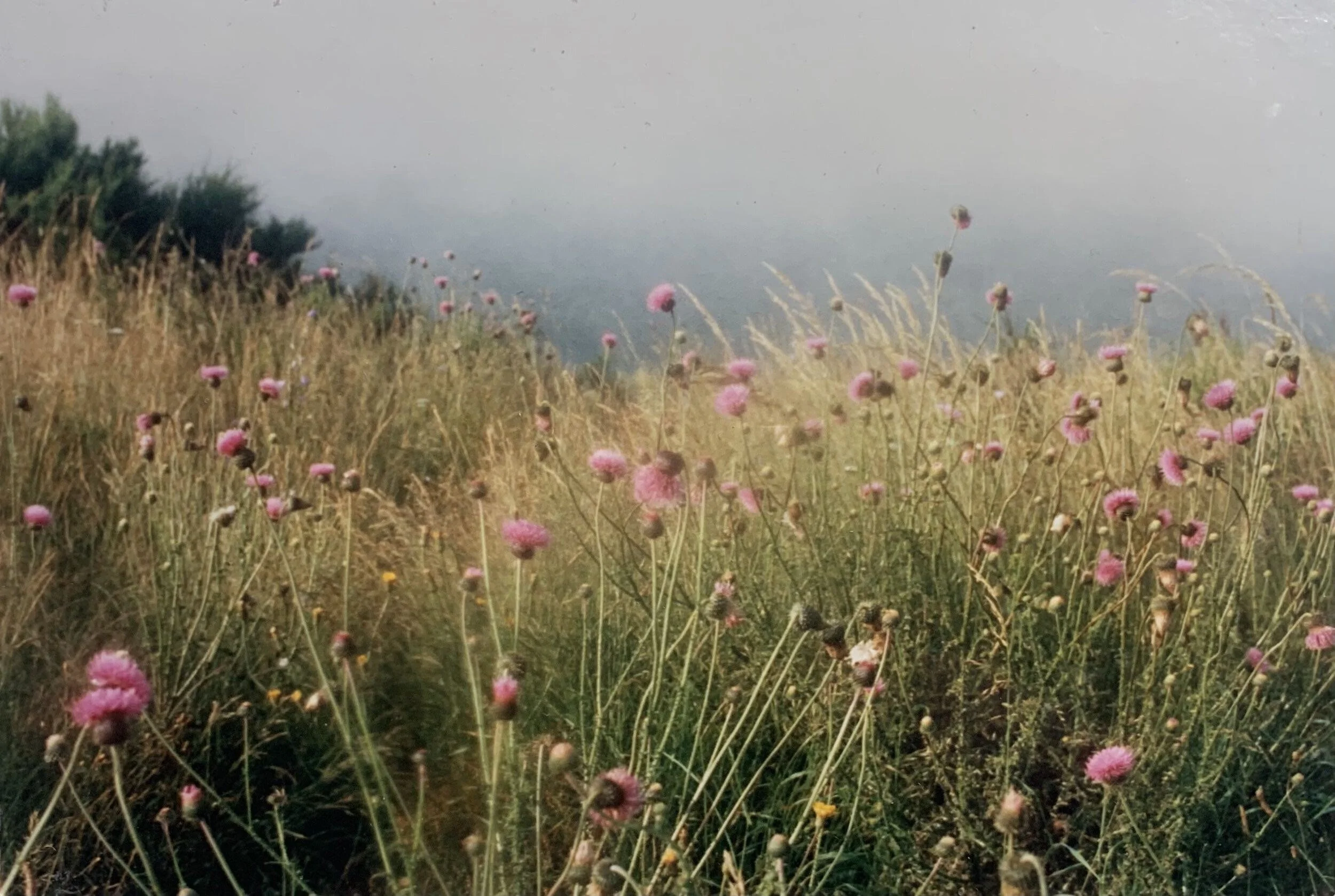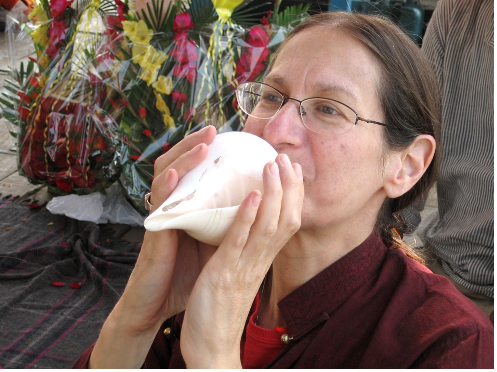Blow the Conch
“Wisdom is the self-liberation of grasping and clinging;
In it there is neither thinking nor a thinker.
It is not ordinary. It is free from fixed convictions.
It is beyond suffering.”
— Rigdzin Jigme Lingpa
“Endless Knot” banner; Tibetan Buddhist symbol of wisdom. Three-month summer retreat at Lerab Ling, Rocquerdonde, France 1992.
________________
“We’d love to see you,’ the Western Buddhist nun crooned at the other end of the line, ‘but you can’t stay on the land. You have to make your own arrangements for housing off-site and for transportation to and from the center.” This rebuff for assistance to attend the Dalai Lama’s teachings at Lerab Ling, Rigpa’s international dharma center in the south of France, only upped my resolve to trump the obstacles. I bit my lip, and put the receiver of the Rigpa Paris office phone back in its cradle.
Months earlier, the emails I posted from Nepal to secure attendance at the teachings had elicited no reply; willy-nilly, I forged ahead and booked a flight from Kathmandu to Paris, heartened by Dodrupchen Rinpoche’s unequivocal counsel on the matter. On landing at Charles DeGaulle Airport, I was greeted by Bernard, a vivacious French fellow and student of Chatral Rinpoche. Bernard understood my mission, put me up in his flat in Meulan, and gallantly drove us here and there, allowing for magic to happen.
Trulshik Rinpoche Ngawang Chokyi Lodro in his private chambers after bestowing nuns vows. Thubten Choling Monastery, Solukhumbu, Nepal, Nov, 1996 (Photo by N. L. Drolma)
I managed to schedule an interview with Trulshik Rinpoche who ordained me back in ‘96. Trulshik Rinpoche was in the City of Light for the weekend, and traveling on to Lerab Ling. Profferring a neatly folded set of my dharma robes to Rinpoche, I expressed a wish that my robes be present at Lerab Ling because it seemed unlikely that I myself could go. My misery was acute. Rinpoche’s eyes bulged at the sight of me offering my dharma robes. It may well have looked as if I was requesting to return my nun’s vows until Tulku Pema Wangyal, who served as translator, clarified my intention. Tulku Pema Wangyal then motioned to someone to pack my dharma wear. Trulshik Rinpoche was leaving later that day for Lerab Ling. Inhibited by the protocol and officious buzz around Rinpoche, I was unable to speak matter-of-factly about my predicament.
Songs of Awakening by Lama Gyurme and Jean-Phillipe Rykiel.
Bernard and I then set off to Kagyu Dzong at Le Parc De Vincennes, where I thought I’d be welcome to enter into retreat. The presiding lama was Kalu Yangsi’s uncle, Lama Gyurmé, whose beautiful CD of chants set to music by Jean-Phillipe Rykiel was played so often in the restaurants and shop fronts in Boudha and Pharping, it seemed ubiquitous like incense in Nepal. As our conversation unfolded, Lama Gyurmé discerned that I wanted to be at Lerab Ling more than in retreat. Consequently, I found myself back in Bernard’s car, staring blankly out the window. What to do?
There were two flights that afternoon to Montpelier.
Bernard was gung-ho to drive to the airport and he prayed along with me that I’d have the good fortune to purchase a seat on the plane that Trulshik Rinpoche’s staff had booked. This would allow me to secure a ride directly to Lerab Ling. If I chose the wrong plane, I’d be stranded.
Sky is blue, blue is sky, sky is sky, and blue is blue! Color me lucky; the plane I booked had few passengers other than Trulshik Rinpoche and his entourage. My ticket put me in Rinpoche’s row—only two seats away, across the aisle! It was comforting to see Rinpoche reading his pechas (i.e., prayer books). The flight was a short hop and a very welcome resolution to the weekend’s dispiriting trials.
At the baggage claim area, I was greeted by an acquaintance from Lerab Ling who came to officially assist Trulshik Rinpoche and his entourage. Tsoknyi Rinpoche appeared and extended a welcoming hand. I was ushered to a black VIP car, no questions asked. My itinerary had unfolded in a Byzantine manner. But the teachings to be extracted from this journey to Lerab Ling were by no means over.
Sogyal Rinpoche, Three-month summer retreat, Lerab Ling, France 1992 (Photo by N. L. Drolma)
Minutes after the sleek limo deposited me along with its august passengers at the retreat center, I met Marieme, my dharma sister who opened her home to me in the fall of 1996 when I last visited France to see Nyoshul Khenpo. She kindly offered to share her offsite accommodations on hearing that housing arrangements for me had fallen through the cracks. Marieme’s invitation was especially soothing because she had witnessed my shock on arrival at the army-like mentality of a few students who physically blocked me in the courtyard and a vajra brother who strong-armed me from offering a khata to Sogyal Rinpoche. Lama Khyenno! I later learned that HH the Dalai Lama was sequestered nearby in the garden of Sogyal Rinpoche’s residence. Apparently, the security team was set on high alert.
The next day, I spotted from afar Trulshik Rinpoche’s nephew and attendant who had been so welcoming and kind during my stay at Thubten Choling Monastery. He was sitting among a genial crowd in Lerab Ling’s refurbished dining hall, the old barn that had been the site for all my meals during the three-month summer retreats I attended at Lerab Ling in 1992, ’93 and ’94. I was making my way to greet him and old friends from those summer days in France, but a student who was stationed at the entrance to the hall barred me from entering, and pointed to a sign posted at the tea stand nearby: FOR VIPs, LAMAS & MONKS ONLY.
This first struck me as a joke. The student, however, was taking the security badge he was wearing very seriously. I resolved to be content with a cup of tea outside the hall. The girl at the tea stand was about to serve me, but a senior student interceded. The student’s security badge prevailed: There was to be no tea offered to this Westerner in nun’s robes. I walked away thinking, yes, I am hallucinating...hal-lu-cin-a-ting! I slipped into one of the plastic, white patio chairs a few yards from the tea stand, and sat there in the cold, looking occasionally in the direction of the tea stand and from time to time in the direction of the dining hall. The frenetic bustle outside the hall and the voices and familiar faces within was surreal, a weirdly animated cartoon. I was experiencing the bardo* of this life as if with x-ray eyes.
* Bardo is the Tibetan term for a transitional state where notions of what’s real and unreal can fall away and allow one’s awareness to recognize its selfless wisdom nature.
I got up to stretch my legs and recognized the American dharma teacher Alan Wallace who was one of the “VIPs” lolling about the courtyard. We exchanged a bit of dharma news, and I elicited his opinion about the tea sign. With a mischievous smile, Alan asked if I would like to see him execute a bit of graffiti. He strode over to the ignominious sign and scribbled on it:
Nuns, too.
The next morning, the sign was nowhere in sight. But at the morning tea break when I asked for tea, once again I was persona non grata. Hours later, after the day’s closing session with HH the Dalai Lama, I entered the courtyard and sat in a patio chair shaded by the table’s umbrella. The girl from the tea stand walked over and offered a heartfelt apology for having refused to serve me on the previous occasions. She had reflected on the dharma politics and no longer cared what the officious students with their walkie-talkies might say or do. She politely requested to bring me a cup of tea. I assented with a grateful nod.
My return to Lerab Ling was a landmine of teachings on the power of forbearance and forgiveness. I had to rise above the provocative dharma scene and not take personally any administrator’s speed, aggression, or heavy-handedness. With thousands in attendance and tight security because of HH the Dalia Lama’s presence, how could there not be ostentatious displays of ego? All that I was experiencing at Lerab Ling (the good and the bad) was an expression of karmic force, and how I chose to react would create more karma accordingly. It lit a fire under me to go beyond karma.
Wild flowers and low-hanging mist; three-month summer retreat, Lerab Ling, France 1992 (Photo by N. L. Drolma)
Lama Khyenno. I missed the rural, quiet spaciousness of this retreat land where I tented years before among wildflowers and the glow of fireflies.
“May all beings live in harmony,” Painting on muslin, children’s art workshop, Lerab Ling, France, 1993 (Photo by N. L. Drolma)
The Dalai Lama’s visit to Lerab Ling was a dharma extravaganza that brought out the best in people, and the worst. It was an event of grand proportion that required the commandeering of a land site near Lerab Ling (designated Lerab Gar) and a tent to accommodate ten thousand people. Several large video screens were suspended from the ceiling so people could see the Dalai Lama from afar. Other tents were set up for mealtime. During a free hour, I wandered over to the children’s arena. Its atmosphere was a nice refuge from the razzmatazz. I connected with a young volunteer who was new to the dharma and flushed with a newcomer’s excitement. She was so open, and her openness reminded me of how fresh and receptive a newbie I had been at HH the Dalai Lama’s Kalachakra teachings in New York City nine years earlier. She took a seat next to me on the second day of teachings and popped the question, “Why aren’t the nuns sitting on the stage with the monks?” There were several lay practitioners seated on stage as well, flanking the Dalai Lama’s throne.
I said to her what I needed to take to heart myself. “Oh, that’s just politics, not dharma. It’s good you ask the question, but don’t get stuck in it. Better to put aside all such concerns in this moment and have a clear, rejoicing mind in the presence of the Dalai Lama. That will help you to hear the teachings in a deep way.”
The wind, rain and troughs of mud at Lerab Gar summed up the state of my own mind during a particular session with the Dalai Lama; although I was physically present for His Holiness’ teaching on “Finding Comfort and Ease in Meditation on the Great Perfection,” I was not a proper vessel for receiving it. My attention, in upheaval from the Felliniesque environment, was focused elsewhere. The bardo of this life was revealing itself nakedly on French terrain. There was nothing I could hold on to. The subtle attachments I had to my “alma mater” Lerab Ling had been exposed and uprooted. The chaos that marked my return to Lerab Ling in the year 2000 mirrored changes within me that had begun to ferment in Nepal in 1996. Living and practicing in Nepal had allowed quotidian life itself to unfold as dharma teachings. It was, therefore, an inevitable and vital teaching for me—not merely a succession of rude jolts—to see Lerab Ling through the lens of nowness.
There is no graduation ceremony in the dharma and no diploma.
*****
After the dharma frenzy at Lerab Ling, it was vividly dreamlike to find myself walking with Bernard through the Palace of Versailles and its Hall of Mirrors; an unparalleled ornate reminder of mind’s clarity and potential to reflect anything ad infinitum. The highly stylized foliage of Versailles’ renowned, stately gardens seemed to extend for miles without end and impressed me as sufficient grounds for contracting agoraphobia.
My subsequent flight back to America in the fall of 2000 marked a six year hiatus in travel overseas. After living out of a suitcase for years and jetting everywhere in a no-frills, ragtag fashion, I established a simple, semi-reclusive lifestyle in New York City in 2022 and travelled sporadically, and only for retreat to Cape Cod, Vermont, California, Seattle, Kentucky, and various regions of New York.
*****
Ganges, Kolkata, Christmas 2008
N. L. Drolma sounding the conch, HH Chatral Rinpoche’s annual fish release, Kolkata, India 2008 (Photo by C. Monson)
I was sitting alone, cross-legged on the floor of the riverboat, conch shell in hand. Semo Saraswati assigned me to blow the conch at the moment the tubs of live fish— ransomed from death in the fish market— were being tipped over the gunwales of the other boats, releasing the lucky fish into the Ganges.
A megaphone was rigged up alongside the boat’s sail, amplifying across the waters the steady sounding of the conch as well as my recitation of prayers and mantra. Coupled with the sincerity of all the participants’ prayers, it is said that imprinting these sacred sounds on the consciousness of the fish can free them from ever again taking hapless, low rebirths. No one on the fish-release suspected I might broadcast an audiotape of Thinley Norbu chanting the Vajra Guru mantra, so when the mantric syllables pierced the air above Kolkata’s waters, full-throated cheers arose from the crews commandeering the tubs of fish. Thinley Norbu’s voice was an inestimable blessing for the fish, and for everyone else too.
The Ganges, its gentle lulling of the boat, the cooling shade of the sail, the conch, and sky— all brought me into a space of sheer magnificence. I was that vast space beyond all reference point...Gaté Gaté Paragaté Parasamgaté Bodhi Soha. There was nothing to renounce and no shore to cross.






